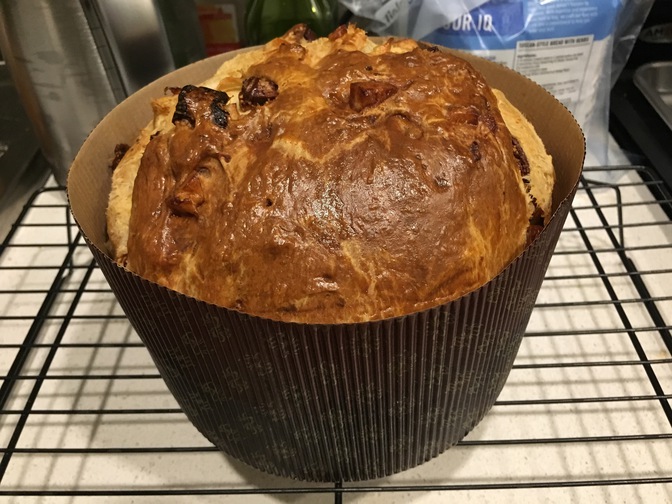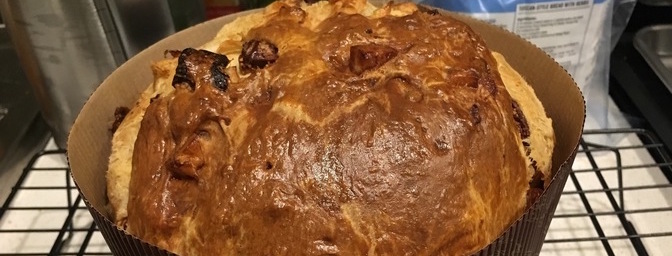
Sourdough Panettone
- Total Time
- 29 hours
- Active Time
- ~1 hour
- Makes
- 1 large loaf
Ingredients
Dough
- 191g whole eggs, beaten (about 4 large eggs)
- 133g whole milk
- 48g granulated sugar
- 200g mature 100% hydration sourdough starter
- zest of 3 oranges
- 1 tsp vanilla extract
- 477g bread flour (I use King Arthur)
- 11g salt
- 191g unsalted cultured butter
Fillings
- 220g diced dried kalamata figs
- 220g diced candided orange peel
Finishing
- 1 egg
Notes
A festive, Italian-inspired holiday loaf. This recipe is somewhat involved, but the results are incredible. As of this writing, it’s the best bread I’ve ever made.
This recipe includes figs and candied orange peel, but you can replace the fillings with any mixture of dried fruit and candied peel you want, as long as it’s diced and totals 440g.
To ensure that the dough is shaped and rises properly, you’ll need either a 7” pannetone pan or a 7” disposeable paper panettone cup (I use the latter).
Directions
Day 1: Making the Dough
- In a bowl with a pour spout, whisk together the eggs, milk, sugar, sourdough starter, orange zest, and vanilla extract.
- In the bowl of a stand mixer, measure out flour and salt. Fit the bowl into the mixer and attach the dough hook. Stir until the flour and salt are combined.
- With the mixer still set to stir, slowly stream in the wet ingredients over the course of about 3 minutes.
- Turn off the mixture and rest the dough for 10 minutes. While the dough is resting, measure out the butter while cutting it into pieces. Let the cut butter stand at room temperature until it’s needed.
- Turn the mixer step by step up to medium and mix for 10 minutes, until there are no large dry clumps of flour and the dough just starts to pull away from the sides of the bowl.
- Over the course of the next 10 or so minutes, slowly incorporate the butter piece by piece with the mixer still running. Wait until each piece of butter is being worked in before adding the next one. You may need to scrape some of the pieces off the side of the bowl with a rubber spatula if they get stuck there and the dough doesn’t pick them back up.
- Turn off the mixer and let the dough rest for another 10 minutes. While the dough is resting, dice and measure out the filling ingredients.
- Dust the filling ingredients with a generous pinch of AP flour and toss to lightly coat.
- Turn the stand mixer up to low and add the fillings in a few installments, waiting for each one to be somewhat uniformly distributed before adding the rest.
- Turn the dough out into a glass bowl, then either wrap the bowl in a proofing bag (I use Reynold’s turkey roasting bags, available near the aluminum foil in most grocery stores), or cover tightly with plastic wrap.
- Proof in a warm spot on the counter for 2 hours. Every 30 minutes, perform a stretch and fold on the dough (for a total of 4 sets of stretching and folding):
- Unwrap the bowl. Grab a handful of dough from the edge and stretch it upwards and outwards.
- Fold the extended dough back down over the top of the rest of it.
- Rotate the bowl and repeat this process, a total of 4 or 5 times, until you’ve come back to where you started.
- Re-wrap the bowl.
- After the last set of stretching and folding, place the wrapped bowl into the fridge, and proof overnight.
Day 2: Shaping, Final Proof, and Baking
- Pull the dough out of fridge. While it’s still cold, turn it out from the bowl onto a lightly floured surface and form it into a smooth ball.
- Place the dough ball into a 7” paper panettone cup set on a quarter or half sheet pan or into a generously buttered 7” panettone pan. Wrap the whole thing in a proofing bag or wrap tightly with plastic wrap.
- Proof in a warm spot on your counter for about 3 hours. Between the enriched dough, fruit filling, and natural yeast, it won’t quite double in size or dome over the top of the sleeve/pan, but it should slowly spring back when you lightly press your forefinger into it.
- Towards the end of the proofing process, preheat your oven to 350ºF and set a rack just below the center of the oven.
- When the dough has been proofed, make an egg wash by beating the final egg with a tablespoon or so of water.
- With a sharp knife, score a few shallow gashes across the top of the loaf.
- Brush the top of loaf down with egg wash and place the dough in the oven. If you’re using a paper sleeve, make sure it’s still set on a quarter or half sheet pan.
- Bake at 350ºF for 25 minutes, then turn the oven down to 300ºF.
- Continue baking at 300ºF until the top is nicely browned and the internal temperature of the bread reaches 190-200ºF. It’s critically important that you take the dough’s temperature because it will look done on the outside before the inside is fully baked. There’s no way to tell just from looking at the outside. The times I’ve made it, this phase has taken 1 to 1½ hours. The exact length can vary quite a bit.
- Remove the bread from the oven, then:
- If you baked it in a panettone pan, wait a few minutes and then extract the bread from the pan and place it on a cooling rack.
- If you baked it in a paper sleeve, move the entire sleeve onto a cooling rack.
- Cool the bread completely, about an hour, before cutting and serving.
